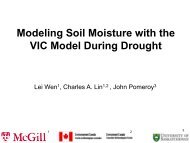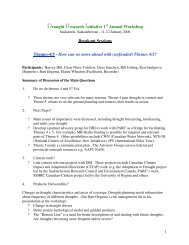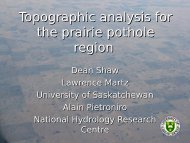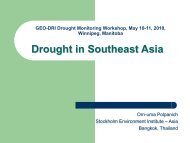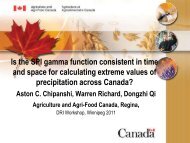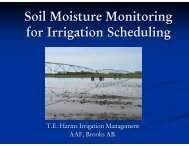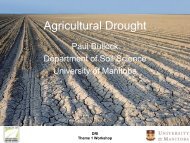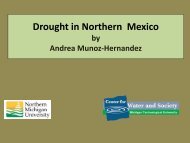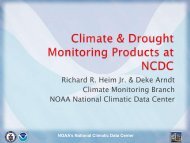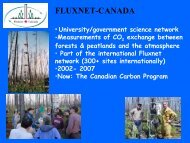SM_Snow_DroughtQuiring.ppt [Read-Only] - Drought Research ...
SM_Snow_DroughtQuiring.ppt [Read-Only] - Drought Research ...
SM_Snow_DroughtQuiring.ppt [Read-Only] - Drought Research ...
Create successful ePaper yourself
Turn your PDF publications into a flip-book with our unique Google optimized e-Paper software.
What Causes <strong>Drought</strong><br />
An Examination of the Role of<br />
Land Surface Conditions<br />
Steven Quiring<br />
DRI Workshop<br />
January 12, 2007<br />
Consul, Saskatchewan (April, 2002)<br />
Ted Banks
Motivation<br />
Koster et al. (2004)
<strong>Research</strong> Objectives<br />
I. Examine the importance of land<br />
surface conditions (snowfall and soil<br />
moisture) in initiating and/or<br />
exacerbating drought conditions in<br />
the Northern Great Plains (NGP)<br />
II.<br />
Can we use snowfall and soil<br />
moisture conditions prior to the<br />
growing season to forecast drought
Evaporation<br />
3) Increased Precipitation<br />
Recycling<br />
Transpiration<br />
<strong>Snow</strong>fall-Soil<br />
moisture-<br />
Precipitation<br />
Feedback<br />
2b) Increased E + T (ET)<br />
POSITIVE<br />
2a) Increased soil<br />
moisture recharge<br />
1) High Winter/Spring <strong>Snow</strong>fall<br />
(or Fall precipitation)
3) Decreased Precipitation<br />
Recycling<br />
Transpiration<br />
<strong>Snow</strong>fall-Soil<br />
moisture-<br />
Precipitation<br />
Feedback<br />
“<strong>Drought</strong> begets drought”<br />
Namias (1960)<br />
Evaporation<br />
2b) Decreased E + T (ET)<br />
2a) Decreased soil<br />
moisture recharge<br />
NEGATIVE<br />
1) Low Winter/Spring <strong>Snow</strong>fall<br />
(or Fall precipitation)
Study Region<br />
55°0'0"N<br />
110°0'0"W<br />
105°0'0"W<br />
100°0'0"W<br />
95°0'0"W<br />
55°0'0"N<br />
•NGP = encompasses<br />
portions of Manitoba,<br />
Saskatchewan, Alberta & 12<br />
US States<br />
50°0'0"N<br />
50°0'0"N<br />
45°0'0"N<br />
40°0'0"N<br />
Moisture Anomaly<br />
< -3<br />
-2 to -3<br />
-1 to -2<br />
0 to -1<br />
0 to 1<br />
1 to 2<br />
2 to 3<br />
> 3<br />
110°0'0"W<br />
105°0'0"W<br />
100°0'0"W<br />
95°0'0"W<br />
Summer (JJA) moisture<br />
anomalies associated<br />
with the 5 driest between<br />
1929 and 1999<br />
45°0'0"N<br />
40°0'0"N<br />
•<strong>Drought</strong> data based on<br />
Palmer’s Moisture Anomaly<br />
Index calculated from station<br />
and climate division data<br />
(interpolated to a 1 by 1<br />
grid)<br />
•Monthly data (1929-1999),<br />
only summer (JJA) moisture<br />
anomalies were analyzed
<strong>Snow</strong>fall Data<br />
•North American gridded<br />
(1 by 1 ) snowfall and<br />
snow cover developed by<br />
T. Mote (Univ. Georgia)<br />
•Interpolated from U.S.<br />
National Weather Service<br />
(NWS) cooperative stations<br />
and the Canadian daily<br />
surface observations<br />
•Daily data (1900-2000)
Soil Moisture<br />
•Variable Infiltration Capacity<br />
(VIC) macroscale hydrological<br />
model<br />
•Developed by Lettenmaier’s<br />
hydrology group at University<br />
of Washington<br />
•3 layer soil water model that<br />
utilizes a soil-vegetationatmosphere<br />
transfer scheme to<br />
account for land-atmosphere<br />
interactions<br />
•Daily simulation over CONUS<br />
at (0.5 by 0.5 ) (1915-2005)
1) Does decreased snowfall lead to<br />
decreased soil moisture recharge<br />
Climatic Water Budget for Northern Minnesota
NGP <strong>Snow</strong>fall & June 1 Soil Moisture<br />
r = 0.43 (similar correlation between seasonal snowfall and May 1 <strong>SM</strong>)
NGP Soil Moisture Composite
2) Are droughts associated with<br />
reduced precipitation recycling<br />
• Recycled precipitation = water from ET that falls<br />
again as rain within the same area (strongly<br />
influenced by size of region)<br />
• Estimates of summer recycling ratios in the NGP<br />
vary (L = 500 km):<br />
– 12% (Trenberth, 1999)<br />
– 14-17% (Dominguez et al., 2006)<br />
– 21% (Raddatz, 2006)<br />
• Local ET provides water vapor and CAPE, linked to<br />
increased convection
Dominguez et al. (2006)
0.19 0.16 0.16 0.13<br />
0.14 0.12<br />
0.16 0.14<br />
Dominguez et al. (2006)
Recycled Precipitation (1980–1999)<br />
r = 0.73
Recycling Ratio (1980–1999)<br />
Compare to Raddatz (2006):<br />
r = 0.43<br />
<strong>Drought</strong> = 0.17<br />
Pluvial = 0.24
3) Are snowfall/SWE anomalies related<br />
to drought
<strong>Snow</strong>fall Composites<br />
Winter<br />
Spring<br />
Dry<br />
Wet<br />
-67 mm -63 mm
NGP <strong>Drought</strong> Composites
NGP April-May <strong>Snow</strong>fall & <strong>Drought</strong><br />
<strong>Snow</strong>fall (blue)<br />
Summer drought (red)<br />
r = 0.22
Temporal Variability<br />
Winter (DJF) (blue line) and April-May (green line) snowfall anomalies and<br />
summer moisture anomalies (Z-index) calculated for all 15 yr time periods<br />
between 1929 and 1999. Dashed lines indicate the 95% significance level.
Summary & Conclusions<br />
• Below (above) normal snowfall in winter/spring is<br />
generally associated with anomalously dry (wet) soil<br />
moisture in May through July and lower (higher)<br />
than normal summer precipitation<br />
• The strength of the relationship between<br />
winter/spring snowfall and summer moisture<br />
anomalies varies significantly over space and time<br />
• Lack of spatial and temporal stability in the snowfalldrought<br />
and soil moisture-drought relationships<br />
have significant implications for understanding and<br />
forecasting these events
Acknowledgements:<br />
T. Mote (University of Georgia)<br />
D. Kluver (University of Delaware)<br />
F. Dominguez (University of Illinois)<br />
E. Wood (University of Washington)<br />
Consul, Saskatchewan (April, 2002)<br />
Ted Banks
4) Can we use soil moisture data to<br />
forecast drought<br />
r = 0.51
Future <strong>Research</strong><br />
• Further analysis of snow and soil moisture<br />
data<br />
• Examine causes of spatial and temporal<br />
variability<br />
• Modeling land-atmosphere interactions<br />
using regional climate model<br />
• Developing hindcast and predictive drought<br />
models for the NGP


![SM_Snow_DroughtQuiring.ppt [Read-Only] - Drought Research ...](https://img.yumpu.com/31928579/1/500x640/sm-snow-droughtquiringppt-read-only-drought-research-.jpg)
